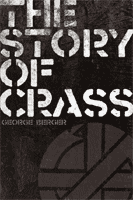

|
The Story Of Crass by George Berger (Omnibus Press 2006)
Crass were Year Zero as far as serious anarcho-punk is concerned. Their vision, visuals and sound are etched into the minds of millions. Whereas Malcolm Maclaren and Johnny Rotten played at attacking the Establishment - spitting all the way to the bank - Penny Rimbaud and Crass were the real thing. Operating from a commune in rural Essex, the many people who made up the outfit waged a guerrilla information war on 'The System'. Their multi-media approach and sharp image and imagery established Crass as a rival anti-Royal Opposition. Everything was called into question, a (simplified) analysis of power was put forward, icons were ridiculed and an alternative suggested - all delivered in 2-minute slices to a savage punk backbeat. The anarcho-punk movement has been practically airbrushed from history by punks "official" spokespeople, despite it's continued existence. According to them, punk existed for about 18 months and comprised of little more than spitting, swearing and being "ironic" . In a sense, they're right - the first wave of what is now called punk sold out to major label companies or died form drugs. It was the fans they left behind that made up the next wave. Lessons were learned and the time was ripe for a second assault. Enter Crass. Serious, dedicated and fiercely political, Crass split the movement down the middle, one half all green mohicans and cider drinking, the other half all dressed in black with stark slogans (and cider drinking). Throughout the band's eight year career they revitalised movements like CND, animal rights and, of course, the many anarchist groups that came and went during the 80's. Berger’s book labours a bit at the start, detailing early, pre-Crass performances undertaken by the group - hippy, freeform affairs. It gets going once the band form as he charts he different routes taken by the various members on their way to the Crass commune. Dial house, the name of the commune, has long been a centre of alternative experimentation and the formation of Crass was essentially a bridge between the fading hippy movement and the up-and-coming punk rockers. Combining pacifist thought with aggressive punk music and image was always a little confusing, not least to Crass themselves. The presence of National Front skinheads at many gigs was for Crass an opportunity to talk to and convert them, but for the many anarchists also at the gig it was a recipe for violence. Crass's naivety in this regard was seen by many city punks as proof that Crass, hiding away in a rural idyll, were removed from the realities of urban life. This negation of reality was to become one of the fault lines along which the band would split in 1984. Gearing people up for revolution whilst denouncing all violence as macho posturing was never going to work. However, the band remain a huge influence on many the world over and Bergers book is a welcome addition to the story. Objective and informative, plus it comes with some excellent photos of a band that did their best to remain anonymous.
|
|
SchNEWS, PO Box 2600, Brighton, BN2 0EF, England Phone +44 (0)1273 685913 email: schnews@brighton.co.uk @nti copyright - information for action - copy and distribute |
|
 At
last, a book about punk that doesn’t mention the Sex Pistols!
Not once! Hooray! Berger has provided us balding anarcho-punks with
a book that has waited to be written for far too long.
At
last, a book about punk that doesn’t mention the Sex Pistols!
Not once! Hooray! Berger has provided us balding anarcho-punks with
a book that has waited to be written for far too long.